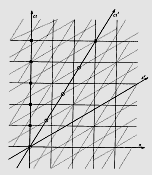Space-Time Lab - Tutor Page 15
 |
Answer: A) Both are right. They are both right because whether or not the ladder fits in the barn depends on the frame in which it is observed. This is because we cannot prescribe any specific event to the situation, so the situation depends on the frame. Look at it like this: in the Michelson-Morley experiment there COULD NOT be any interference on the interferometer because having no interference was an event, and is independent of frame. If I fail a physics test, I fail no matter how anyhow views me in my rest frame. The same thing goes for the Michelson-Morley experiment. If different interference patterns are seen from different rest frames, then something is definitely wrong with one or all of Einstein's assumptions. So what classifies something as an event? In the barn and ladder paradox, we are asking whether or not the end of the ladder was in the barn before the front left therough the back. This is a question of whether or not something came before or after something else, which is a frame dependant question. However, in the Michelson-Morley experiment we ask the question does something happen or not happen (or 'does something exist'). The reason why the order of things changes from frame to frame is because of the change of the time and space axes. You may have noticed on the space-time diagrams that when something is given a high velocity, their time and space axes are no longer perpendicular, but become 'crooked'. This means that two things simultaneous, i.e., have the same time and lie on a straight line perpendicular to the time axis, are no longer simultaneous when the time axis is moved. This demonstrates that while events are independent of frame, simultaneity and causality are not. Click Next to see how Einstein corrected classical mechanics. |
| Back Page 15 Next | A B C |
Questions or Comments? Send email to phys1@its.caltech.edu | |